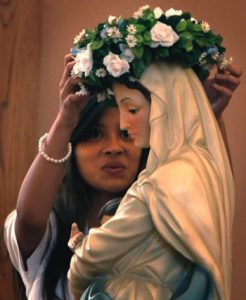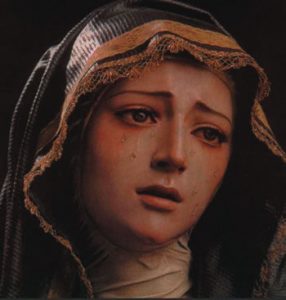Mary for the Third Millennium (1)
A Sensitive Topic
This is not a matter of gazing into a crystal ball and trying to read the future. The directions of Mary for the Third Millennium are already well in place. What happened in the past influences the present and shapes the future. After almost two years of reflection on Mary, those of you who have been through the previous issues must have some ideas on emerging directions and certain trends that are becoming clearer. The next few reflections serve as a reminder and a drawing together.
Veneration of the Blessed Mother has been a central characteristic of the Catholic tradition. Consider some of the following aspects of past and present devotion to Mary:
-- Gang members tattooing images of the Virgin of Guadalupe on their backs as a shield against the bullets of rivals;
-- Pilgrimage sites (like Lourdes, France, Croatia) that draw hundreds of thousands every year; 
-- Icons that weep fragrant oil, statues that weep tears, and ghostly images that appear on unlikely places like office-building windows in Florida;
-- Museums filled with pictures, statues, tapestries, and ceramics depicting everything from Mary’s Assumption into heaven to her ‘fishing’ souls into paradise using a Rosary for a lifeline;
-- Parish school May crowns of flowers; novenas in honor of the Miraculous Medal or the Seven Sorrows; and the once everywhere present Rosaries wound around the hands of the faithful at Mass or as they rest for a final viewing before the coffin is closed.
Mary in her Life
Oscar Romero once said that “faith which is lived in isolation from life is not faith” (Sermon #3). It could be equally said that a Mary that is isolated from life is not a Mary for today. By the middle of last century the mother of Jesus had been frozen in time, trapped in images created by Renaissance artists, placed on a pedestal, and elevated beyond our reach. It has been rightly said that every age creates its own picture of Mary. In the early 21st century we need a new appreciation of Mary, one that is faithful to the teachings of Vatican II, yet, at the same time, respectful of the varied and rich traditions we have inherited. Mary, woman of courage and strength, should have a central place in our spirituality. But we have to develop a new language to describe Mary, a theology of Mary that is suitable for today. We reflected on the struggle to obtain that in the monumental shift in approach to Mary that took place at Vatican II.
We could well lament that we have lost the woman behind the devotion; we praise her miracles and forget her person. Mary is very like us (Lumen Gentium 54) fully a member of God’s people, and on our side. Mary lives as one of us, first among the faithful, but one of us. Mary’s life was a genuine human journey. To deny that is to take her out of the ranks of humanity and is unfair to her and to all of us. She was not, and never will be, divine. Pope John XXIII stated “The Madonna is not happy when she is placed before her Son”. To persist today in applying titles to Mary that appear to give her the qualities of God brings confusion rather than clarity.
The Human Face of Mary
Mary was a Jewish woman of her day who observed the Sabbath and all the practices associated with the special fervour of the anawim, or poor of Yahweh, among whom s he was numbered.
Mary is very like us ... fully a member of God’s people, and on our side
Hers was a commonplace and obscure life. Here was a woman who searched, felt anxious, laughed and cried, did not understand everything, and had to find her way from one stage to another as she travelled life’s journey. And life did not treat her gently. She lived through the human lot that falls to us all: tears, distress and bitterness, courage and greatness, agony and death. She was probably illiterate, unable to read like the vast majority of men and women of her day.
A priest in a small parish told of an earthquake that smashed a church statue of Mary. He told his devout housekeeper. Her reply surprised him. She said she was pleased the statue was broken. He asked her “Why?” Her reply - the statue looked nothing like the Mary she believed in. It looked more like a film star rather than a peasant woman who had to bring up a child and work hard in the ordinary life of the village (Fr. Kevin Barr).
The mission
The challenge we face is to take her gently down from her pedestal and place her within the human condition and the communion of saints, of which she is an honoured member. To bring her down to us is not to put her down – there is a world of difference between the two. We recall her as a young Jewish woman, wife, and mother, of a peasant tradition, who faced difficult decisions, living in a war torn region.
What was life like for a Palestinian woman in the first century? Life in a hill country village such as Nazareth depended on agriculture. Mary would have spent between 4 to 5 hours a day working with others in the fields around the village, planting, weeding, and harvesting. Nearer home was a small family plot of vegetables and fruit trees, work that fitted in with caring for children, not only her own child, but those of the wider family with whom they lived under the one roof, the relatives in the story of the visit to Jerusalem.
Add to this the cooking of meals, processing grain for bread, storing of food for the winter months (grains, olives, fruit, and herbs). The face of the Mary of history is a very human one. Perhaps it is easier to relate to her as one who shares our life and work than as a distant semi-divine being, so different from us!
Therese of Lisieux reminds us that we love Mary not because the Mother of God received exceptional privileges but rather because she lived and suffered simply, like us, in the dark night of faith. “For a sermon on the Blessed Virgin to please me…I must see her real life…They (writers and homilists?) show her to us as un-approachable, but they should present her as imitable, bringing out her virtues, saying that she lived by faith just like ourselves, giving proofs of this from the Gospels”. Mary was a daughter of this earth; she had human passions and joys. She shared all of the human concerns that we experience. She waited expectantly for the coming of the Messiah, looking at her world through the eyes of faith. As an individual, she made difficult choices in life with courage, and grew, in time, to be an elder in the budding community of the Church. She is our sister in faith.
Sources:
Cunningham, Lawrence
There’s Something about Mary, Claretian Press.
Johnson, Elizabeth.
Truly Our Sister, Continuum.


 Entries(RSS)
Entries(RSS)